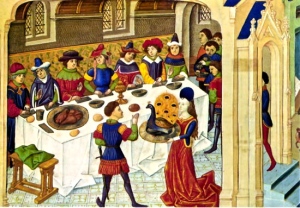1. Christmas wasn’t the jovial holiday of today.
In medieval times, the celebration of this particular holiday was taken very seriously, for it was a celebration of the birth of Christ. Hours-long masses were attended daily during this holiday – which lasted until the Egyptian winter solstice on January 6th.

But that didn’t mean there was no fun to be had after mass. Who wouldn’t need to party after praying solemnly day after day for hours on end? Long masses were followed by performances and dances in villages and castles.
In the villages, peasants reveled boisterously with much singing, dancing, food donated by the rich, and fountains of ale arranged by the King.
In castles, there would be professional musicians, actors, dancers, jesters…mounds upon mountains of foodstuffs…and wines from all the countries most famous for their grapes.

.
2. Turkey was not on the European medieval Christmas meal menu.
Why not?
Turkeys were indigenous to America, which was not ‘discovered’ by them until the late 15th century. Medieval Europeans stuffed themselves with goose and other birds, boar and deer. However, peasants were not permitted to eat the most edible parts; they could only eat the heart, the liver, the tongue, feet, ears, and brains.

To improve the taste of these ‘umbles,’ they would mix it all into a pie with whatever else they could get their lowly hands on. This became known as ‘umble pie,’ and it’s where we get our modern day expression about an uppity person being knocked down a peg and having to eat “humble pie.”
The medieval rich and royalty also used the expression ‘umble pie’ to insult one another with this implication of poverty.
.
3. There was another Christmas bird eaten by medievals…but only by the King.
Swan.

Anyone other than the King caught killing or eating a swan, would be charged with treason and hanged or beheaded.
Swan was untouchable without written permission from the monarch – and Kings were not at all generous about putting quill to parchment in this matter. You see, swan represented the ultimate meal, fit for a King. The more people permitted to eat it, the less caché it would have. It’s association with royalty would be tainted were it to be eaten by noblemen, or worse, mere peasants.
.
4. Not everyone survived a medieval Christmas.
There are documented stories of people “joyfully drowning” in the holiday ale fountains provided for peasants by the King. And, of course, those who attempted to sneak a swan meal lost their heads.
But there were other medievals who were absolutely terrified of this bonny holiday.
Children.

Children??
Aren’t they the very ones who would be beaming bright smiles at Christmas?
Well, not exactly.
Not even close.
First of all, ‘bright smile’ was an oxymoron during medieval times. Teeth back then were normally shades of black from rot and prehistoric dentistry practices.
Secondly, Christmas and medieval children – boys, specifically – were a deadly combination.
Why?
December 28th was Massacre of the Innocents Day.

This was the day King Herod – in his attempt to end the life of the unknown newborn King of the Jews, decreed that all boys under 2 years old be executed.
And, even centuries after that hellish event, medievals took December 28th very seriously.
Some parents would hide their children. Others stuffed their children’s clothing with leaves or hay.
Why?
Because in town squares across England, children would be beaten with stripped branches and leather straps so that all were reminded of Herod’s cruelty. It was believed that witnessing the children’s pain would melt the hardest of hearts and thereby insure future protection of children against any repeat of a Massacre of the Innocents.
.
5. Were there Christmas trees in medieval times?

Well, the tree has always been an important hallmark in most medieval cultures. The oak was worshipped by the Druids. Ancient Romans imbued the evergreen with magical powers, and decorated them with hangings symbolizing a renewal of life in spring – which they equated with eternal life for Christians. Even the Vikings had their favorite trees – the ash, and the fir – which they decorated with war souvenirs collected during their rampages.
On Christmas Eve, the Church hung apples on trees to celebrate Adam & Eve Day. And Germans strung crafted flowers and religious symbols around fir trees, marching through the streets with them to a town center where the trees would be ceremoniously set aflame.
.
Which of these medieval facts of Christmas could you celebrate without?
.

See all 5 Medieval Facts of Life posts!

As a retired history teacher, I REALLY enjoyed the post. I understand that among Europeans the English had the worst teeth as tea was drunk with half dozen spoons of sugar. Apparently in Roman times, dental hygiene was frowned upon as the Jews referred to the Romans as “those teeth washers” which was part of Roman morning toiletry.
I didn’t know this about the Jews’ view of Roman dental hygiene. I had a suspicion about English teeth from Queen Elizabeth I’s penchant for chewing “sweetmeats” (candy) all day, every day because of her belief that it masked bad breath. (And she was all gaga over Dudley & wanted to keep her breath sweet for their close encounters 😛 ) If you have an interest in ancient dental details, take a look at my post “Butt Breath.”
Thanks for sharing this info, Carl – I find these kinds of details fascinating!
Pingback: Another Great VBA Post – Sylver Blaque « Versatile Blogger Award
Hey SITSta! Love your blog!
Thanks, SITSta! 🙂
Great factoids. Thanks for the research!
Interesting, isn’t it? But glad I’m living in this era!